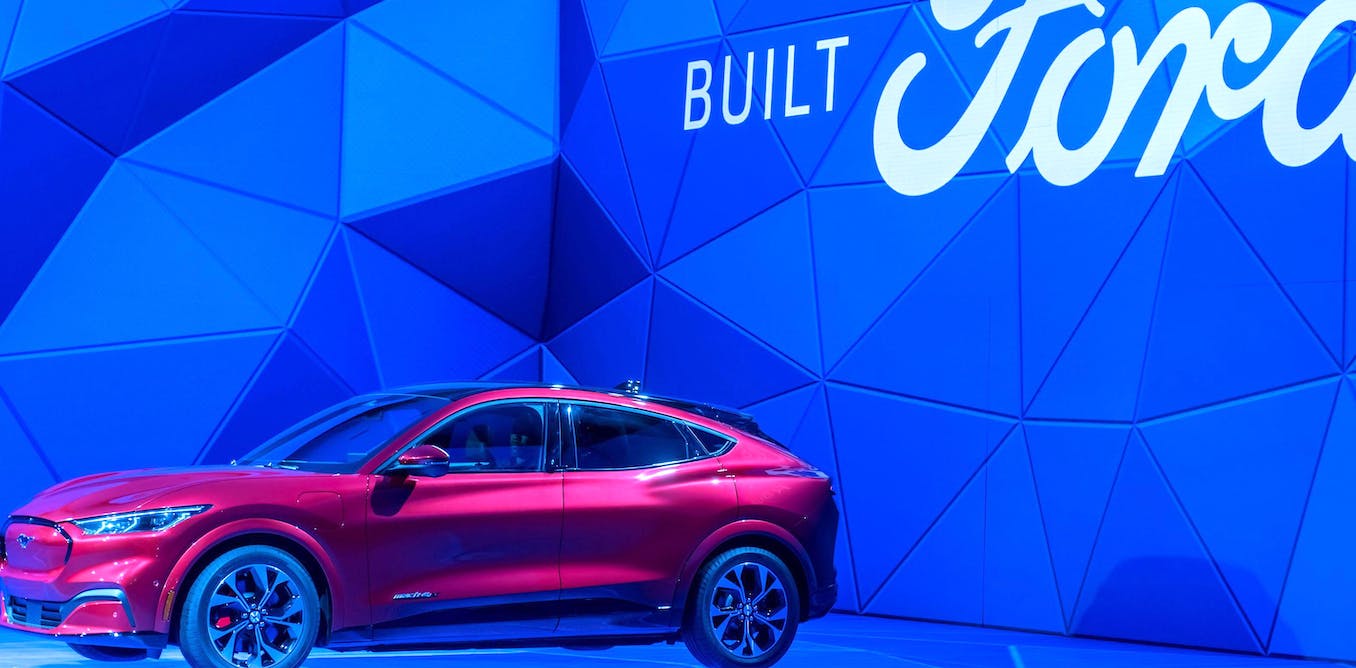The UK’s efforts to become a global player in electric vehicles (EVs) are back in the spotlight with two government announcements: a £500 million loan guarantee for Ford and a £73 million package to support various smaller clean transport projects.
The loan guarantee is enabling Ford to spend £230 million on its Halewood plant near Liverpool to nearly double output of EV powertrains to 420,000 units a year. Powertrains are the motor and other parts that propel EVs forward.
It is also helping Ford to invest £370 million in its global R&D headquarters in Essex to help support EV development. Ford’s Mustang Mach-E SUV is one of the best selling EVs in the world, though it is currently made in Mexico.
The government’s second £73 million package is a 50-50 investment with the auto industry. Among five projects receiving support is one aiming to develop a more efficient way of manufacturing EVs.
While these announcements are very welcome, we have seen numerous similar ones in recent years. But what’s the the big picture? How far is the UK from being a powerhouse in global EV?
Assembly lines
The UK currently produces over 850,000 cars a year, the vast majority petrol and diesel. Over 700,000 are exported, more than half to the EU.
The biggest producers are Nissan in Sunderland, BMW Mini at Cowley near Oxford, Jaguar Landrover at three sites in the Midlands and north west, and Vauxhall at Ellesmere Port in Cheshire. Since all new cars must be at least hybrid by 2030 and completely electric by 2035, all these groups are undergoing major transformations.
Nissan gave the UK an early lead in EVs with the Leaf, building it in Sunderland since 2013. On the back of a recent £1 billion investment, the group is now also making hybrid Qashqais and Jukes at the plant, as well as lining up a replacement for the Leaf.
john angerson/Alamy
The news with the other players is more mixed. Vauxhall will start making electric vans at Ellesmere in 2023, but has ceased Astra production there and will make new EV versions in Germany instead. Similarly, Mini is relocating electric production to China, with owner BMW saying the UK plant is not currently up to the task.
As for Jaguar Landrover, it has been investing in its UK plants to ensure that some EV models will be made there, but others may reportedly be made abroad, as is already the case with its Austria-made i-Pace.
Ford’s powertrains investment is a solid commitment to the UK, but there are no signs it will start making cars here again. It is due to start making EVs in Germany and Romania in the next two years. Nissan is the only other player that makes EV powertrains in the UK.
In all, the UK’s share of European EV assembly and production has fallen from 25% in 2018 to what industry sources tell us is about 10% today, and it’s forecast to drop to 5% by 2030. Germany is making four times more EVs than the UK – or around a third of the European total – while France and Slovakia are also ahead.
It does not help that UK consumers are somewhat lukewarm about EVs. The UK is only 17th in terms of EV ownership per head, way behind leaders Norway and the US.
Gigafactories
The main obstacle to UK success, however, is batteries. They are easily the heaviest EV component, so having production close to assembly plants is essential for reducing costs. And if producers in the UK are going to avoid EU import tariffs from 2027, they also need locally made batteries to qualify as “made in the UK”.
The EV battery market is dominated by China, but Europe and the US are battling to catch up.
Nissan Sunderland is the cornerstone of UK efforts, since there is an adjacent battery plant owned by Chinese supplier Envision AESC. Once the biggest plant in Europe but long since outgunned by continental rivals, Envision’s 3-4 gigawatt hours (GWhrs) of annual output are enough for just 40,000 cars. But once a current expansion completes in 2024 it will produce 11GWhrs, potentially later expanding to 38GWhrs.

Ricky Deacon/Alamy
A second gigafactory in north-east England is in the offing in Blyth, Northumberland by start-up Britishvolt. It aims to produce 30GWhrs of annual capacity, but has funding problems and has been sounding out buyers. It is yet to announce any major supply deals and is several years away from production.
There is also a plant proposal in advanced planning in Coventry in the West Midlands. This joint venture between the local council and airport aims to produce 60GWhrs of batteries each year.
These three plants could service about 1.2 million cars a year – more than enough to power the UK’s entire output. But the government would like to go further, attracting another five gigafactories with a further 100GWhrs of capacity by 2027.
With gigafactories costing several billion pounds each, the government has been subsidising the existing projects to help get them moving. It has also committed £211 million to battery research and innovation through the Faraday Battery Challenge.
One potential advantage is substantial lithium deposits in Cornwall, so the government has been subsidising Cornish developers too. With enough lithium to power the entire UK requirement, it could yet become the 21st century equivalent of North Sea oil.
The competition
It still feels like the UK could win a good share of the EV market, but it is going to have to get its gigafactories up and running. With UK battery output still tiny, the temptation is for EV producers to move overseas.
In all, Europe now makes between about 10% and 15% of the global total. Hungary and Poland are currently the first and second biggest producers in Europe, but a huge push in recent years by Germany to become a hub for assembly lines, batteries and EVs in general is set to eclipse them by 2025 to become the second biggest world player after China.
Germany benefits from having had a larger auto industry for the past few decades than the UK, due to a much more joined up system of education, government and manufacturers working together. This means it can invest more into building battery factories and production lines. If the UK wants a bigger share of this business, it will need to invest more and think more strategically.
This is not like 60 years ago, when Prime Minister Harold Wilson invested in science and technology to help drive innovations that were as yet unknown. Today, we have the technologies, but need to develop the necessary systems and infrastructure. If the UK is to put itself at the heart of the EV boom, it needs a mega project-level investment to make it work – and quickly. The ball is very much in the politicians’ court.




